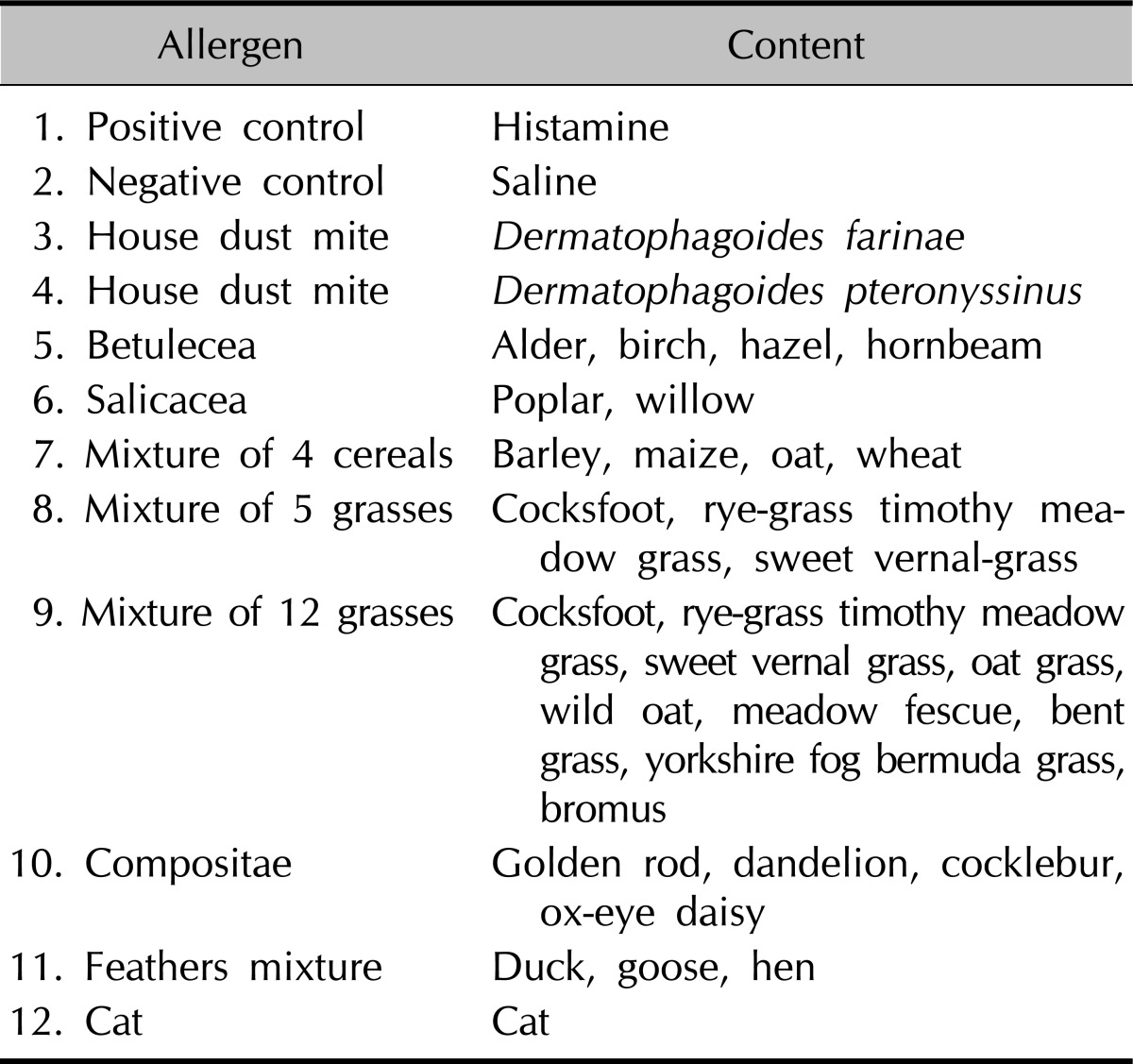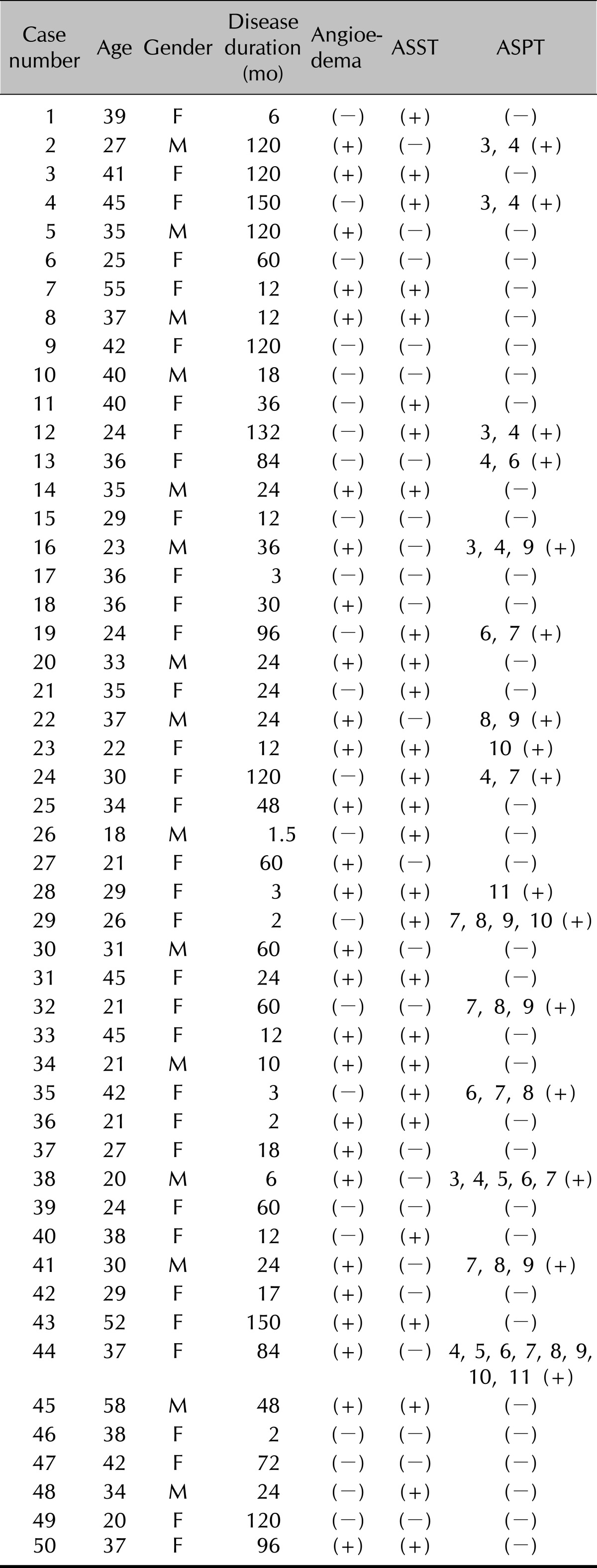Dear Editor:
The etiology of chronic urticaria (CU) cannot be identified in more than 75% of patients, even after an exhaustive search. The autologous serum skin test (ASST) based on the intradermal injection of autologous serum is a simple screening diagnostic procedure used in CU. Studies have shown that ASST is positive in almost half of patients with CIU1. Aeroallergen prick skin test (ASPT) can provide useful confirmatory evidence for immediate type I hypersensitivity2. The purpose of our study was to assess the prevalence of positivity of ASST and ASPT, and their relevance in patients with CU. Fifty CU patients (female/male: 35/15, mean age: 33.32±9.42 years) and 50 controls (female/male: 20/30, mean age: 36.84±13.13 years), who were classified according to age and gender, were included in the study. In all of the patients, physical urticaria, food and drug allergies, as well as urticarial vasculitis, were ruled out after taking a detailed history and performing relevant laboratory investigations. Clinical and laboratory details of all of the patients were recorded, using a standard format. The ASST and the ASPT were performed intradermally. The aeroallergen, used for ASPT, were Dermatophagoides farinae, D. pteronyssinus, betulecea (alder, birch, hazel, hornbeam), salicacea (poplar, willow), mixture of 4 cereals (barley, maize, oat, wheat), mixture of 5 grasses (cocksfoot, rye-grass timothy meadow grass, sweet vernal-grass), mixture of 12 grasses (cocksfoot, rye-grass timothy meadow grass, sweet vernal grass, oat grass, wild oat, meadow fescue, bent grass, yorkshire fog bermuda grass, bromus), compositae (golden rod, dandelion, cocklebur, ox-eye daisy), feathers mixture (duck, goose, hen), and cat. Data were analyzed by using SPSS 11.5 software (SPSS Inc., Chicago, IL, USA). Ki kare test was used for the statistical analytical approach, and t test was used for other variables. There was a significant difference between patients (27 patients, range: 34%) and controls (5 controls, range: 10%), according to ASST positivity (p<0.001). The ASPT was positive in 32% of the patient group, and in 26% of the control group. The difference between the 2 groups was not meaningful (p>0.5). The most prevalent aeroallergens in the patients were D. farinae (16% of patients). Sixteen percent of the patients reacted to a mixture of 4 cereals, 12% reacted to a mixture of 5 grasses and 12% reacted to a mixture of 12 grasses. The difference, according to the controls, was not meaningful (p>0.05).
ASST has been suggested as a screening test for CIU. In our study, based on the disease duration, there was no significant difference between the ASST positive and negative groups, similarly, the studies of Kultanan et al.2 and Nettis et al.3 Grattan et al.4 reported a 35% positive ASST result in patients with CU. Coban et al.5 found a positive ASST in 25 of 40 patients (62.5%) with CC. Our findings are similar to those reported in those studies. CIU can be provoked by a number of known and unknown factors and allergens. Some of these allergens can be identified by prick tests. In our study, the most positive reactions were seen with house dust mites. Caliskaner et al.6 prick tested 259 patients with CU with common aeroallergens. Seventy-one of the patients had positive reactions to one or more allergens. The most common allergens were house dust mites, followed by pollens, cockroaches and moulds. Tezcan et al.7 prick tested 5,055 patients, 556 of whom had CU. According to this study, 42% of patients reacted to house dust mites, 54% reacted to grass pollen and 45% reacted to cereal pollen. In our study, ASPT positivity was not high because the living area is not mouldy. In addition, both the number and species of plants and pollens are scarce. In our setting, ASST is the only available test for the diagnosis of autoimmune urticaria. It is a simple and inexpensive, semi-invasive and easy-to-perform test, which can be undertaken by a dermatologist to determine whether the patient's CIU is autoimmune in origin. As conventional approaches to management may be unsuccessful, ASST is especially important from the therapeutic point of view, as it can help the dermatologist to determine whether to initiate immunosuppressive therapy in CIU patients. When investigating the etiology of patients with CIU, the ASPT should be made with anamnesis.
Table 1.
The used antigens in the study
Table 2.
Features and results of patients
ASST: autologous serum skin test, ASPT: aeroallergen prick skin test, F: female, M: male.
References
- 1.Greaves M. Chronic urticaria. J Allergy Clin Immunol. 2000;105:664–672. doi: 10.1067/mai.2000.105706. [DOI] [PubMed] [Google Scholar]
- 2.Kulthanan K, Jiamton S, Gorvanich T, Pinkaew S. Autologous serum skin test in chronic idiopathic urticaria: prevalence, correlation and clinical implications. Asian Pac J Allergy Immunol. 2006;24:201–206. [PubMed] [Google Scholar]
- 3.Nettis E, Dambra P, D'Oronzio L, Cavallo E, Loria MP, Fanelli M, et al. Reactivity to autologous serum skin test and clinical features in chronic idiopathic urticaria. Clin Exp Dermatol. 2002;27:29–31. doi: 10.1046/j.0307-6938.2001.00962.x. [DOI] [PubMed] [Google Scholar]
- 4.Grattan CE, Wallington TB, Warin RP, Kennedy CT, Bradfield JW. A serological mediator in chronic idiopathic urticaria--a clinical, immunological and histological evaluation. Br J Dermatol. 1986;114:583–590. doi: 10.1111/j.1365-2133.1986.tb04065.x. [DOI] [PubMed] [Google Scholar]
- 5.Coban M, Erdem T, Ozdemir S, Pirim I, Atasoy M, Ikbal M. HLA class I and class II genotyping in patients with chronic urticaria. Int Arch Allergy Immunol. 2008;147:135–139. doi: 10.1159/000135700. [DOI] [PubMed] [Google Scholar]
- 6.Caliskaner Z, Ozturk S, Turan M, Karaayvaz M. Skin test positivity to aeroallergens in the patients with chronic urticaria without allergic respiratory disease. J Investig Allergol Clin Immunol. 2004;14:50–54. [PubMed] [Google Scholar]
- 7.Tezcan D, Uzuner N, Sule Turgut C, Karaman O, Köse S. Retrospective evaluation of epidermal skin prick tests in patients living in Aegean region. Allergol Immunopathol (Madr) 2003;31:226–230. doi: 10.1016/s0301-0546(03)79183-6. [DOI] [PubMed] [Google Scholar]




